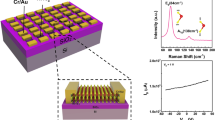Abstract
As a narrow gap, strongly correlated electron semiconductor, FeSb2 single crystals can exhibit a colossal thermopower1 (on the order of −40,000 μV/K or greater) and a relatively high lattice thermal conductivity2 (over 300 W/m-K) at temperatures around 10 K. In this work, a series of FeSb2 polycrystalline samples with different amounts of additional Indium were prepared by a quench-and-anneal method followed by a spark plasma sintering procedure. The x-ray diffraction, scanning electron microscopy, and elemental analysis verified that the Sb/InSb nanoinclusions were formed in situ on the boundaries of coarse FeSb2 grains. The presence of such nanoinclusions and other as-formed multiscale microstructures can scatter phonons and thus dramatically reduce the corresponding lattice thermal conductivity. Furthermore, the electrical properties can be also improved because of the addition of high mobility carriers from the InSb nanoinclusions. Overall, FeSb2-based materials have shown some promising potential for possible thermoelectric cooling applications at cryogenic temperatures.







Similar content being viewed by others
REFERENCES
A. Bentien, S. Johnsen, G.K.H. Madsen, B.B. Iversen, and F. Steglich: Colossal Seebeck coefficient in strongly correlated semiconductor FeSb2. Europhys. Lett. 80, 17008 (2007).
P. Sun, N. Oeschler, S. Johnsen, B.B. Iversen, and F. Steglich: Narrow band gap and enhanced thermoelectricity in FeSb2. Dalton Trans. 39, 1012 (2010).
T.M. Tritt and M.A. Subramanian: thermoelectric materials, phenomena, and applications: a bird’s eye view. MRS Bull. 31, 188 (2006).
T.M. Tritt, Harald Bottner, and Lidong Chen: Thermoelectrics: Direct solar thermal energy conversion. MRS Bull. 33, 336 (2008).
L.E. Bell: Cooling, heating, generating power, and recovering waste heat with thermoelectric systems. Science 321, 1457 (2008).
A. Bentien, G.K.H. Madsen, S. Johnsen, and B.B. Iversen: Experimental and theoretical investigations of strongly correlated FeSb2-xSnx. Phys. Review B 74, 205105 (2006).
P. Sun, N. Oeschler, S. Johnsen, B.B. Iversen, and F. Steglich: FeSb2: Prototype of huge electron-diffusion thermoelectricity. Phys. Review B 79, 153308 (2009).
Y. Sun, S. Johnsen, P. Eklund, M. Sillassen, J. Bottiger, N. Oeschler, P. Sun, F. Steglich, and B.B. Iversen: Thermoelectric transport properties of highly oriented FeSb2 thin films. J. Appl. Phys. 106, 033710 (2009).
W. Xie, X. Tang, Y. Yan, Q. Zhang, and T.M. Tritt: Unique nanostructures and enhanced thermoelectric performance of melt-spun BiSbTe alloys. Appl. Phys. Lett. 94, 102111 (2009).
A.L. Pope, B. Zawilski, and T.M. Tritt: Description of removable sample mount apparatus for rapid thermal conductivity measurements. Cryogenics 41, 725 (2001).
A.L. Pope, R.T. Littleton IV, and T.M. Tritt: Apparatus for the rapid measurement of electrical transport properties for both “needle-like” and bulk materials. Rev. Sci. Instrum. 72, 3129 (2001).
V.V. Kosarev, P.V. Tamarin, and S.S. Shalyt: Thermal conductivity of indium antimonide at low temperatures. Phys. Status Solidi B 44, 525 (1971).
D.L. Rode: Electron transport in InSb, InAs, and InP. Phys. Rev. B 3, 3287 (1971).
G.A. Slack: CRC Handbook of Thermoelectrics (CRC Press, Boca Raton, FL, 1995), p. 407.
C. Kittel: Introduction to Solid State Physics, 8th ed. (John Wiley & Sons, Berkeley, CA, 2005), pp.112–114.
D.G. Cahill, S.K. Watson, and R.O. Pohl: Lower limit to the thermal conductivity of disordered crystals. Phys. Rev. B: Condens. Matter 46, 6131 (1992).
ACKNOWLEDGMENTS
We thank Dr. Jian He and Dr. Catalina Marinescu in the Department of Physics and Astronomy of Clemson University for their inspired discussions. We would like to acknowledge the financial support from DOE/EPSCoR Implementation Grant (No. DE-FG02-04ER-46139) and SC EPSCoR Office/Clemson University cost sharing.
Author information
Authors and Affiliations
Corresponding author
Rights and permissions
About this article
Cite this article
Zhu, S., Xie, W., Thompson, D. et al. Tuning the thermoelectric properties of polycrystalline FeSb2 by the in situ formation of Sb/InSb nanoinclusions. Journal of Materials Research 26, 1894–1899 (2011). https://doi.org/10.1557/jmr.2011.86
Received:
Accepted:
Published:
Issue Date:
DOI: https://doi.org/10.1557/jmr.2011.86




